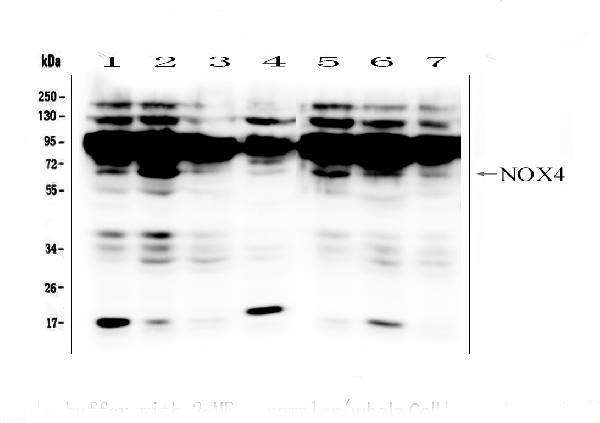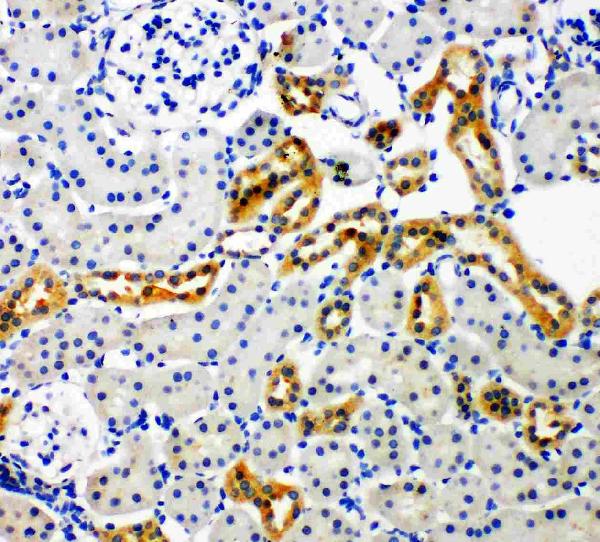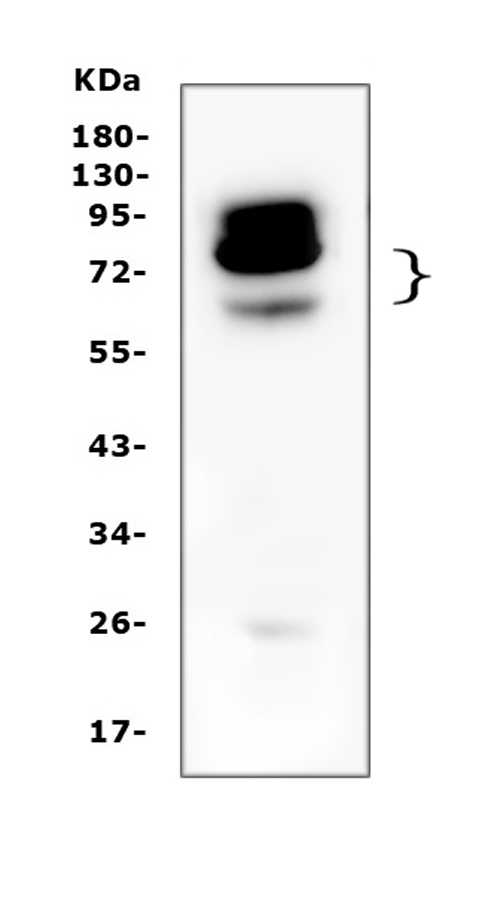Product Info Summary
| SKU: | PA1929 |
|---|---|
| Size: | 100 μg/vial |
| Reactive Species: | Human, Mouse, Rat |
| Host: | Rabbit |
| Application: | Flow Cytometry, IHC, IHC-F, ICC, WB |
Customers Who Bought This Also Bought
Product info
Product Name
Anti-NADPH oxidase 4/NOX4 Antibody Picoband®
SKU/Catalog Number
PA1929
Size
100 μg/vial
Form
Lyophilized
Description
Boster Bio Anti-NADPH oxidase 4/NOX4 Antibody catalog # PA1929. Tested in Flow Cytometry, IHC, IHC-F, ICC, WB applications. This antibody reacts with Human, Mouse, Rat. The brand Picoband indicates this is a premium antibody that guarantees superior quality, high affinity, and strong signals with minimal background in Western blot applications. Only our best-performing antibodies are designated as Picoband, ensuring unmatched performance.
Storage & Handling
Store at -20˚C for one year from date of receipt. After reconstitution, at 4˚C for one month. It can also be aliquotted and stored frozen at -20˚C for six months. Avoid repeated freeze-thaw cycles.
Cite This Product
Anti-NADPH oxidase 4/NOX4 Antibody Picoband® (Boster Biological Technology, Pleasanton CA, USA, Catalog # PA1929)
Host
Rabbit
Contents
Each vial contains 5mg BSA, 0.9mg NaCl, 0.2mg Na2HPO4, 0.05mg Thimerosal, 0.05mg NaN3.
Clonality
Polyclonal
Isotype
Rabbit IgG
Immunogen
A synthetic peptide corresponding to a sequence at the C-terminus of mouse NADPH oxidase 4, identical to the related rat sequence and different from the related human sequence by two amino acids.
*Blocking peptide can be purchased. Costs vary based on immunogen length. Contact us for pricing.
Cross-reactivity
No cross-reactivity with other proteins
Reactive Species
PA1929 is reactive to Nox4 in Human, Mouse, Rat
Reconstitution
Add 0.2ml of distilled water will yield a concentration of 500ug/ml.
Observed Molecular Weight
67 kDa
Calculated molecular weight
66519 MW
Background of Nox4
NADPH oxidase 4 is an enzyme that in humans is encoded by the NOX4 gene, and is a member of the NOX family of NADPH oxidases. This gene encodes a member of the NOX-family of enzymes that functions as the catalytic subunit the NADPH oxidase complex. The encoded protein is localized to non-phagocytic cells where it acts as an oxygen sensor and catalyzes the reduction of molecular oxygen to various reactive oxygen species (ROS). The ROS generated by this protein have been implicated in numerous biological functions including signal transduction, cell differentiation and tumor cell growth. A pseudogene has been identified on the other arm of chromosome 11. Alternative splicing results in multiple transcript variants.
Antibody Validation
Boster validates all antibodies on WB, IHC, ICC, Immunofluorescence, and ELISA with known positive control and negative samples to ensure specificity and high affinity, including thorough antibody incubations.
Application & Images
Applications
PA1929 is guaranteed for Flow Cytometry, IHC, IHC-F, ICC, WB Boster Guarantee
Assay Dilutions Recommendation
The recommendations below provide a starting point for assay optimization. The actual working concentration varies and should be decided by the user.
Western blot, 0.1-0.5μg/ml, Human, Rat, Mouse
Immunohistochemistry (Paraffin-embedded Section), 0.5-1μg/ml, Rat, Human, Mouse, By Heat
Immunohistochemistry (Frozen Section), 0.5-1μg/ml, Human
Immunocytochemistry, 0.5-1μg/ml, Human
Flow Cytometry (Fixed), 1-3μg/1x106 cells, Human
Positive Control
WB: human HepG2 whole cell, human SW620 whole cell, human HK-2 whole cell, human HL-60 whole cell, human 293T whole cell, human SW579 whole cell, human SK-OV-3 whole cell, rat kidney tissue
IHC: rat kidney tissue
FCM: U20S cell
Validation Images & Assay Conditions

Click image to see more details
Figure 1. Western blot analysis of NADPH oxidase 4/NOX4 using anti-NADPH oxidase 4/NOX4 antibody (PA1929).
Electrophoresis was performed on a 5-20% SDS-PAGE gel at 70V (Stacking gel) / 90V (Resolving gel) for 2-3 hours. The sample well of each lane was loaded with 50ug of sample under reducing conditions.
Lane 1: human HepG2 whole cell lysates,
Lane 2: human SW620 whole cell lysates,
Lane 3: human HK-2 whole cell lysates,
Lane 4: human HL-60 whole cell lysates,
Lane 5: human 293T whole cell lysates,
Lane 6: human SW579 whole cell lysates,
Lane 7: human SK-OV-3 whole cell lysates.
After Electrophoresis, proteins were transferred to a Nitrocellulose membrane at 150mA for 50-90 minutes. Blocked the membrane with 5% Non-fat Milk/ TBS for 1.5 hour at RT. The membrane was incubated with rabbit anti-NADPH oxidase 4/NOX4 antigen affinity purified polyclonal antibody (Catalog # PA1929) at 0.5 μg/mL overnight at 4°C, then washed with TBS-0.1%Tween 3 times with 5 minutes each and probed with a goat anti-rabbit IgG-HRP secondary antibody at a dilution of 1:10000 for 1.5 hour at RT. The signal is developed using an Enhanced Chemiluminescent detection (ECL) kit (Catalog # EK1002) with Tanon 5200 system. A specific band was detected for NADPH OXIDASE 4/NOX4 at approximately 67KD. The expected band size for NADPH OXIDASE 4/NOX4 is at 67KD.

Click image to see more details
Figure 2. IHC analysis of NADPH OXIDASE 4/NOX4 using anti-NADPH OXIDASE 4/NOX4 antibody (PA1929).
NADPH OXIDASE 4/NOX4 was detected in paraffin-embedded section of rat kidney tissues. Heat mediated antigen retrieval was performed in citrate buffer (pH6, epitope retrieval solution) for 20 mins. The tissue section was blocked with 10% goat serum. The tissue section was then incubated with 1μg/ml rabbit anti-NADPH OXIDASE 4/NOX4 Antibody (PA1929) overnight at 4°C. Biotinylated goat anti-rabbit IgG was used as secondary antibody and incubated for 30 minutes at 37°C. The tissue section was developed using Strepavidin-Biotin-Complex (SABC)(Catalog # SA1022) with DAB as the chromogen.

Click image to see more details
Figure 3. Flow Cytometry analysis of U20S cells using anti-NADPH oxidase 4/NOX4 antibody (PA1929).
Overlay histogram showing U20S cells stained with PA1929 (Blue line). To facilitate intracellular staining, cells were fixed with 4% paraformaldehyde and permeabilized with permeabilization buffer. The cells were blocked with 10% normal goat serum. And then incubated with rabbit anti-NADPH oxidase 4/NOX4 Antibody (PA1929, 1μg/1x106 cells) for 30 min at 20°C. DyLight®488 conjugated goat anti-rabbit IgG (BA1127, 5-10μg/1x106 cells) was used as secondary antibody for 30 minutes at 20°C. Isotype control antibody (Green line) was rabbit IgG (1μg/1x106) used under the same conditions. Unlabelled sample without incubation with primary antibody and secondary antibody (Red line) was used as a blank control.

Click image to see more details
Figure 4. Western blot analysis of NADPH oxidase 4/NOX4 using anti-NADPH oxidase 4/NOX4 antibody (PA1929).
Electrophoresis was performed on a 5-20% SDS-PAGE gel at 70V (Stacking gel) / 90V (Resolving gel) for 2-3 hours. The sample well of each lane was loaded with 50ug of sample under reducing conditions.
Lane 1: rat kidney tissue lysate.
After Electrophoresis, proteins were transferred to a Nitrocellulose membrane at 150mA for 50-90 minutes. Blocked the membrane with 5% Non-fat Milk/ TBS for 1.5 hour at RT. The membrane was incubated with rabbit anti-NADPH oxidase 4/NOX4 antigen affinity purified polyclonal antibody (Catalog # PA1929) at 0.5 μg/mL overnight at 4°C, then washed with TBS-0.1%Tween 3 times with 5 minutes each and probed with a goat anti-rabbit IgG-HRP secondary antibody at a dilution of 1:10000 for 1.5 hour at RT. The signal is developed using an Enhanced Chemiluminescent detection (ECL) kit (Catalog # EK1002) with Tanon 5200 system. Specific bands were detected for NADPH oxidase 4/NOX4 at approximately 67-80KD. The expected band size for NADPH oxidase 4/NOX4 are at 67-80KD.
Protein Target Info & Infographic
Gene/Protein Information For Nox4 (Source: Uniprot.org, NCBI)
Gene Name
Nox4
Full Name
NADPH oxidase 4
Weight
66519 MW
Alternative Names
NADPH oxidase 4;1.6.3.-;Kidney oxidase-1;KOX-1;Kidney superoxide-producing NADPH oxidase;Renal NAD (P)H-oxidase;Superoxide-generating NADPH oxidase 4;Nox4;Renox; Nox4|AI648021|NADPH oxidase 4|NADPH oxidase 4|KOX-1|kidney oxidase-1|kidney superoxide-producing NADPH oxidase|renal NAD(P)H-oxidase|superoxide-generating NADPH oxidase 4
*If product is indicated to react with multiple species, protein info is based on the gene entry specified above in "Species".For more info on Nox4, check out the Nox4 Infographic

We have 30,000+ of these available, one for each gene! Check them out.
In this infographic, you will see the following information for Nox4: database IDs, superfamily, protein function, synonyms, molecular weight, chromosomal locations, tissues of expression, subcellular locations, post-translational modifications, and related diseases, research areas & pathways. If you want to see more information included, or would like to contribute to it and be acknowledged, please contact [email protected].
Specific Publications For Anti-NADPH oxidase 4/NOX4 Antibody Picoband® (PA1929)
Hello CJ!
PA1929 has been cited in 2 publications:
*The publications in this section are manually curated by our staff scientists. They may differ from Bioz's machine gathered results. Both are accurate. If you find a publication citing this product but is missing from this list, please let us know we will issue you a thank-you coupon.
Deficiency of NOX1 or NOX4 Prevents Liver Inflammation and Fibrosis in Mice through Inhibition of Hepatic Stellate Cell Activation
Obligatory role for GPER in cardiovascular aging and disease^
Recommended Resources
Here are featured tools and databases that you might find useful.
- Boster's Pathways Library
- Protein Databases
- Bioscience Research Protocol Resources
- Data Processing & Analysis Software
- Photo Editing Software
- Scientific Literature Resources
- Research Paper Management Tools
- Molecular Biology Software
- Primer Design Tools
- Bioinformatics Tools
- Phylogenetic Tree Analysis
Customer Reviews
Have you used Anti-NADPH oxidase 4/NOX4 Antibody Picoband®?
Submit a review and receive an Amazon gift card.
- $30 for a review with an image
0 Reviews For Anti-NADPH oxidase 4/NOX4 Antibody Picoband®
Customer Q&As
Have a question?
Find answers in Q&As, reviews.
Can't find your answer?
Submit your question
5 Customer Q&As for Anti-NADPH oxidase 4/NOX4 Antibody Picoband®
Question
We bought anti-NADPH oxidase 4/NOX4 antibody for IHC-P on nephron tubule last year. I am using rat, and We want to use the antibody for Flow Cytometry next. I am interested in examining nephron tubule as well as lung in our next experiment. Could you please give me some suggestion on which antibody would work the best for Flow Cytometry?
Verified Customer
Verified customer
Asked: 2020-01-16
Answer
I have checked the website and datasheets of our anti-NADPH oxidase 4/NOX4 antibody and it appears that PA1929 has been tested on rat in both IHC-P and Flow Cytometry. Thus PA1929 should work for your application. Our Boster satisfaction guarantee will cover this product for Flow Cytometry in rat even if the specific tissue type has not been validated. We do have a comprehensive range of products for Flow Cytometry detection and you can check out our website bosterbio.com to find out more information about them.
Boster Scientific Support
Answered: 2020-01-16
Question
We have seen staining in human nephron tubule. Do you have any suggestions? Is anti-NADPH oxidase 4/NOX4 antibody supposed to stain nephron tubule positively?
Verified Customer
Verified customer
Asked: 2019-12-13
Answer
Based on literature nephron tubule does express NOX4. Based on Uniprot.org, NOX4 is expressed in nephron tubule, kidney, fetal kidney, lung, pulmonary artery, ovary, among other tissues. Regarding which tissues have NOX4 expression, here are a few articles citing expression in various tissues:
Fetal kidney, Pubmed ID: 11376945
Kidney, Pubmed ID: 10869423, 11032835
Lung, Pubmed ID: 15721269
Ovary, Pubmed ID: 15489334
Pulmonary artery, Pubmed ID: 14702039
Boster Scientific Support
Answered: 2019-12-13
Question
We are interested in using your anti-NADPH oxidase 4/NOX4 antibody for defense response studies. Has this antibody been tested with western blotting on hepg2 whole cell lysates? We would like to see some validation images before ordering.
K. Li
Verified customer
Asked: 2018-02-23
Answer
I appreciate your inquiry. This PA1929 anti-NADPH oxidase 4/NOX4 antibody is validated on human 293t whole cell lysates, hepg2 whole cell lysates, sw620 whole cell lysates, rat kidney tissue, tissue lysate, u20s cells. It is guaranteed to work for Flow Cytometry, IHC-P, IHC-F, ICC, WB in human, mouse, rat. Our Boster guarantee will cover your intended experiment even if the sample type has not been be directly tested.
Boster Scientific Support
Answered: 2018-02-23
Question
We are currently using anti-NADPH oxidase 4/NOX4 antibody PA1929 for human tissue, and we are happy with the ICC results. The species of reactivity given in the datasheet says human, mouse, rat. Is it true that the antibody can work on feline tissues as well?
S. Jackson
Verified customer
Asked: 2015-03-12
Answer
The anti-NADPH oxidase 4/NOX4 antibody (PA1929) has not been validated for cross reactivity specifically with feline tissues, though there is a good chance of cross reactivity. We have an innovator award program that if you test this antibody and show it works in feline you can get your next antibody for free. Please contact me if I can help you with anything.
Boster Scientific Support
Answered: 2015-03-12
Question
Our team were content with the WB result of your anti-NADPH oxidase 4/NOX4 antibody. However we have observed positive staining in nephron tubule endoplasmic reticulum membrane using this antibody. Is that expected? Could you tell me where is NOX4 supposed to be expressed?
A. Krishna
Verified customer
Asked: 2014-06-25
Answer
According to literature, nephron tubule does express NOX4. Generally NOX4 expresses in endoplasmic reticulum membrane. Regarding which tissues have NOX4 expression, here are a few articles citing expression in various tissues:
Fetal kidney, Pubmed ID: 11376945
Kidney, Pubmed ID: 10869423, 11032835
Lung, Pubmed ID: 15721269
Ovary, Pubmed ID: 15489334
Pulmonary artery, Pubmed ID: 14702039
Boster Scientific Support
Answered: 2014-06-25





